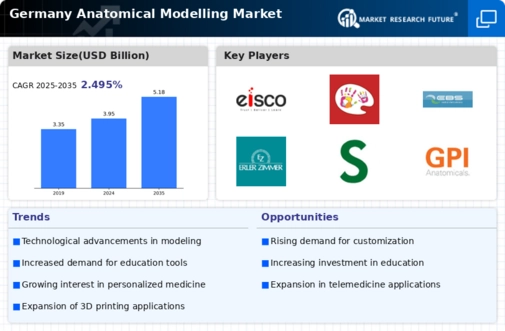Growing Demand for Medical Training
The anatomical modelling market in Germany is experiencing increased demand for improved medical training solutions. As medical education evolves, there is an increasing emphasis on practical, hands-on training that utilizes anatomical models. These models serve as essential tools for students and professionals to practice surgical techniques and understand human anatomy in a controlled environment. The increasing number of medical schools and training institutions in Germany is driving this demand. Additionally, the integration of anatomical models into curricula is becoming more prevalent, as educators recognize their value in improving learning outcomes. This trend is expected to drive the anatomical modelling market, with an estimated market value reaching €150 million by 2026, reflecting a robust growth trajectory.
Rising Prevalence of Chronic Diseases
The rising prevalence of chronic diseases in Germany is influencing the anatomical modelling market. As the population ages, there is an increasing incidence of conditions such as cardiovascular diseases, diabetes, and musculoskeletal disorders. This trend necessitates advanced medical interventions and surgical procedures, which in turn drives the demand for anatomical models. These models are essential for preoperative planning and patient-specific simulations, allowing healthcare professionals to tailor their approaches to individual cases. The anatomical modelling market is expected to grow in response to this demand, with estimates suggesting a market size increase of €200 million by 2027. This growth reflects the critical role that anatomical models play in addressing the complexities of chronic disease management.
Technological Advancements in Imaging
The anatomical modelling market in Germany is experiencing a surge due to advancements in imaging technologies. Innovations such as MRI, CT scans, and 3D imaging are enhancing the precision of anatomical models. These technologies allow for the creation of highly detailed and accurate representations of human anatomy, which are crucial for medical education and surgical planning. The integration of these imaging techniques into the anatomical modelling market is expected to drive growth, as they facilitate better understanding and visualization of complex anatomical structures. Furthermore, the increasing demand for high-fidelity models in surgical simulations and training programs is likely to propel the market forward. As a result, the anatomical modelling market is projected to expand significantly, with a compound annual growth rate (CAGR) of approximately 8% over the next five years.
Increased Investment in Healthcare R&D
Investment in healthcare research and development (R&D) is a significant driver for the anatomical modelling market in Germany. The government and private sector are allocating substantial funds to advance medical technologies, including anatomical modelling. This investment is aimed at improving patient outcomes and enhancing the efficiency of healthcare delivery. As a result, the anatomical modelling market is likely to benefit from increased funding for innovative projects that utilize advanced modelling techniques. Furthermore, collaborations between universities, research institutions, and industry players are fostering the development of new anatomical models that cater to specific medical needs. This collaborative approach is expected to enhance the market's growth potential, with projections indicating a market expansion of approximately 10% annually over the next few years.
Emergence of Virtual Reality in Healthcare
Virtual reality (VR) technology is set to transform the anatomical modelling market in Germany. VR applications are increasingly being integrated into medical training and surgical planning, providing immersive experiences that enhance understanding of anatomical structures. This technology allows for interactive simulations, enabling healthcare professionals to visualize and manipulate 3D anatomical models in real-time. The adoption of VR in medical education is gaining traction, as it offers a novel approach to learning that can improve retention and comprehension. As the anatomical modelling market embraces these technological advancements, it is likely to see a surge in demand for VR-compatible models. Projections indicate that the market could experience a growth rate of 12% annually, driven by the increasing integration of VR in healthcare settings.




















Leave a Comment